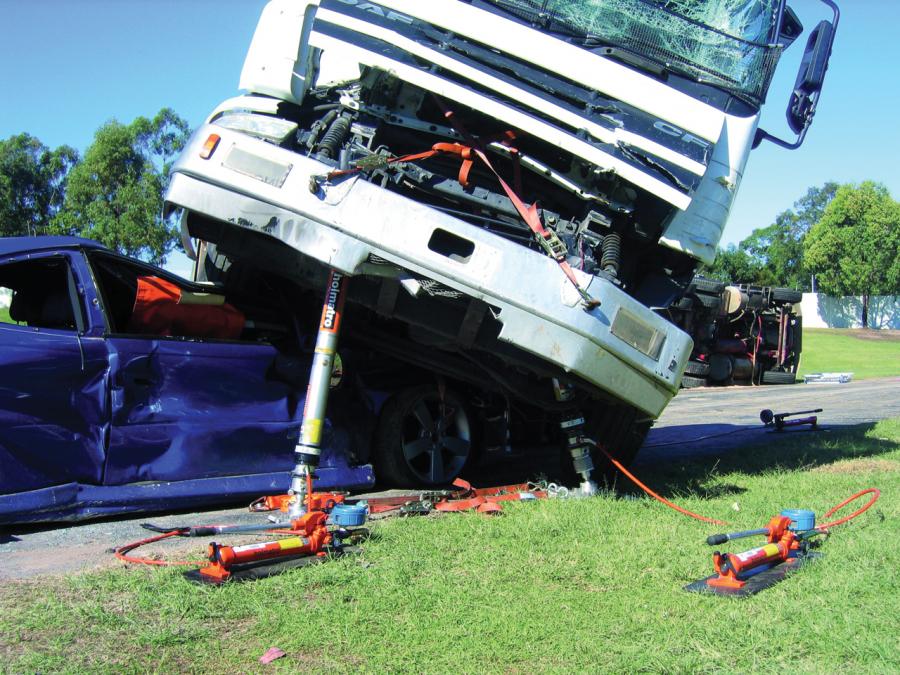Truck Incidents
Incidents involving trucks remain a topic that is very often discussed when it comes to vehicle extrication. In recent blogs, I have talked about how experience breeds confidence and competence with equipment such as hydraulic rams; well the same applies to certain types of incidents.
Incident types
Truck incidents, in comparison to ‘normal’ cars, are relatively rare and in my experience often involve either an under run (where a car is under the cab or trailer of the truck) or where a truck has collided with the rear of another large vehicle, trapping the driver. In addition, I have also attended incidents where trucks have turned over and landed on their side requiring extrication of the driver. All of these kinds of incidents offer different challenges and I am constantly reminded of how rescuers all around the world feel ill prepared for such eventualities. For this blog, I will provide a few considerations for an incident involving an under run.
Lack of exposure
Of course, obtaining trucks to train on is very difficult. This is principally due to the fact that in most countries, old trucks still have a commercial value for spare parts and therefore finding a ‘wreck’ is nearly impossible and if you can, they are very expensive. There is also a huge lack of commercial options for this kind of training; courses are hard to find. All of this conspires against the rescuer and is the main reason that we may feel a little exposed when we arrive on scene. So what can we do?
What can you do to prepare yourself?
Well, there is no substitute for actually getting out and having a look at a truck in the flesh, even if you cannot cut it. Can you go to a truck dealer or a truck park? Familiarise yourself with the anatomy of the vehicle and look for features such as:
- Pneumatic suspension (identify the inflatable bags)
- Pneumatic braking system and associated tanks
- Drop axle (sometimes called drop)
- Cab stabilization process
If a car has collided with the trailer (front or side), any or all of these systems could be damaged, therefore greatly affecting the stability of the truck and compromising scene safety.
More tips
Before any rescuer goes underneath the trailer section of the truck a ‘safety cell’ must be created. This will ensure the trailer is stable and cannot move in any direction, in particular, downwards. This can be done using wooden cribbing, but a shoring system is quicker and safer. In addition, a shoring system gives you the option of lifting later on if required. Once the safety cell has been established, work can begin.
Of course, an early consideration MUST be the load contained in/on the truck. Consider if it is solid, liquid or gas and how this can affect stability and lifting operations if required. A hazardous load will require specialist intervention and this should be considered early along with all other resources.
Something I learned a long time ago is that a truck engine that is running will likely maintain the pressure in a pneumatic system, so consider leaving the engine running (if possible) until the safety cell is created.
A car that has under run a truck will often provide very difficult access for you patient inside. As a result, I would always suggest that very early in the extrication, the possibility of vehicle relocation is considered. Very often a well-executed vehicle relocation will greatly reduce your extrication time. If relocation is not feasible, then it is simply a case of making as much internal/external space as possible with which to extricate your patient.
If vehicle relocation is required, it is important to remember that the time it takes to relocate the vehicle forms part of your overall scene time and must be carefully considered and be dependent upon your patient’s injuries and condition; do you have time?
Conclusion
Incidents involving trucks continue to challenge rescuers worldwide simply due to lack of operational exposure. Any kind of incident we do not regularly train for is immediately going to compromise our safety and performance when we arrive on scene and rescuers sometimes have to be resourceful when it comes to finding information. An underrun incident will challenge not only your extrication techniques, but also your knowledge of vehicle anatomy in relation to trucks; something that must be understood and acted upon before the extrication process really starts. It is all about exposure and you must find a way to expose yourself to these kinds of vehicles in a training environment; only then will we be safe, competent and more importantly, confident.
As ever, I welcome your feedback!
Ian Dunbar
